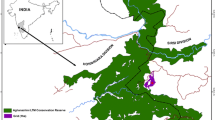Abstract
The feeding ecology of rhesus monkeys,Macaca mulatta, was studied between 1978 and 1981. The study site, located in the Murree Hills of northwestern Pakistan, supported a mixed coniferous-deciduous forest community and was characterized by a high degree of human disturbance. We used a linear transect method to sample the species composition and structure of the vegetation. Comparison of these data with historical records showed that the forest has undergone major changes in the last hundred years. Data on feeding behavior were collected through on-the-minute focal animal sampling. The monkeys spent about 45% of the day feeding. Their preferred foods were grass, clover, and other ground herbs that occur in the disturbed sites. Fruit accounted for less than 9% of feeding records. The rhesus monkey may be pre-adapted to living in disturbed-site, forest-edge communities. The evolutionary history of Macaca mulatta may be tied closely to the disappearance of forest and the spread of meadows and savannahs over the last million years.
Similar content being viewed by others
References
Banno, R. (1981).Vocal Communication in Free-ranging Rhesus Monkeys (Macaca mulatto). M. Phil, dissertation, Quaid-I-Azam University, Islamabad, Pakistan.
Bauer, H. L. (1936). Moisture relations on the chaparral of the Santa Monica Mountains, California.Eco. Mono. 6: 409–454.
Burgess, R. L., and Sharpe, M. D. (1981).Forest Island Dynamics in Man-Dominated Landscapes, Springer-Verlag, New York.
Burns, C. (in prep.).Diet, Social Status and Reproduction in Rhesus Macaques, Macaca mulatto. Ph.D. dissertation, Yale University, New Haven, Connecticut.
Burton, E. S. V. (1938).Working Plan for the Galis Forests, India Records Office.
Champion, H. (1936). A preliminary survey of the forest types of India and Burma.India Forest Records, 1(1).
Clutton-Brock, T. H. (1977). Some aspects of intraspecific variation in feeding and ranging behavior in primates. In Clutton-Brock, T. H. (ed.),Primate Ecology, Academic Press, New York, pp. 539–556.
Dewar, R. E., Goldstein, S. G., and Richard, A. F. (1981).Macaca mulatto in forest undergoing anthropogenic change.Am. J. Phys. Antropol. 54: 214.
Dewar, R. E., and Goldstein, S. G. (in prep). History of the Galis Forests, northwest Pakistan.
Dittus, W. P. J. (1979). The social regulation of population density and age-sex distribution in the toque monkey.Behaviour 63: 281–322.
Eudey, A. A. (1980). Pleistocene glacial phenomena and the evolution of Asian macaques. In Lindburg, D. G. (ed.),The Macaques: Studies in Ecology, Behavior and Evolution, Van Nostrand, New York, pp. 55–83.
Goldstein, S. G. (1984).Feeding Ecology of Rhesus Monkeys (Macaca mulatto) in Northwestern Pakistan. Ph.D. dissertation, Yale University, New Haven, Connecticut.
Greswell, E. A. (1923).Working Plan for the Galis Forests, India Records Office.
Lindburg, D. G. (1971). The rhesus monkey in North India: An ecological and behavioral study. In Rosenblum, L. A. (ed.),Primate Behavior: Developments in Field and Laboratory Research, Academic Press, New York, pp. 1–106.
Malik, I., and South wick, D. H. (1988). Feeding behavior and activity patterns of rhesus monkeys (Macaca mulatto) at Tughlaqabad, India. In Fa, J. E., and Southwick, C. H.,Ecology and Behavior of Food-Enhanced Primate Groups, Alan Liss, New York, pp. 95–112.
Mandai, A. K. (1964). The behaviour of rhesus monkeys (Macaco mulatto Zimmerman) in the Sundarbans.J. Bengal Nat. Hist. Soc. 33: 153–165.
Marriott, B. (1978). Feeding patterns of wild rhesus monkeys (Macaca mulatto) in Kathmandu, Nepal.Fed. Prod. 37(3): 759.
Matthiae, P. E., and Stearns, F. W. (1981). Mammals in forest islands in Southeastern Wisconsin. In Burgess, R. L., and Sharpe, M. D.,(eds.),Forest Island Dynamics in Man-Dominated Landscapes, Springer-Verlag, Berlin, pp. 55–66.
Melnick, D. (1981).Microevolution in a Population of Himalayan Rhesus Monkeys (Macaca mulatto). Ph.D. dissertation, Yale University, New Haven, Connecticut.
Monroe, A. V. (1905).Working Plans for the Galis Forests, India Records Office.
Niering, W. A., and Egler, F. E. (1955). A shrub community ofViburnum lentago stable for 25 years.Ecology 36: 356–360.
Niering, W. A., and Goodwin, R. H. (1974). Creation of relatively stable shrublands with herbicides: Arresting succession on rights-of-way and pastureland.Ecology 55: 784–795.
Partridge, L. (1987). Habitat selection. In Krebs, J. R., and Davies, N. B. (eds.),Behavioral Ecology: An Evolutionary Approach, Sinauer Associates, Sunderland, Massachusetts, pp. 34–73.
Pearl, M. C. (1982).Networks of Social Relations Among Himalayan Rhesus Monkeys. Ph.D. dissertation, Yale University, New Haven, Connecticut.
Post, D., Hausfater, G., and McCuskey, S. (1980). Feeding behavior of yellow baboons (Papio cynocephahis): Relationship to age, gender, and dominance rank.Folia Primatol. 34: 170–195.
Ranney, J. W. (1977).Forest Island Edges-Their Structure, Development and Importance to Regional Forest Ecosystem Dynamics. Oak Ridge National Laboratory, Oak Ridge, Tennessee.
Richard, A. F., Goldstein, S. G., and Dewar, R. E. (1989). Weed macaques: the evolutionary implications of macaque feeding ecology.Int. J. Primatol. 10: 569–594.
Roberts, T. J. (1978).The Mammals of Pakistan, Benn, London.
Shah, S. A. R. (1962).Working Plan for the Galis Forests, Pakistan Forest Department.
Siddiqi, M. F., and Southwick, C. H. (1988). Food habits of rhesus monkeys (Macaca mulatto) in the north Indian plains. In Fa, J. E., and Southwick, C. H. (eds.),Ecology and Behavior of Food-Enhanced Primate Groups, Alan Liss, New York, 113–124.
Southwick, C. H., Beg, M. A., and Siddiqi, M. R. (1965). Rhesus monkeys in North India. In De Vore, I. (ed.),Primate Behavior: Field Studies of Monkeys and Apes, Holt Reinhart and Winston, New York, pp. 111–159.
Southwick, C. H., and Siddiqi, M. F. (1976). Demographic characteristics of semi-protected rhesus groups in India.Yb. Phys. Anthrop. 20: 242–252.
Southwick, C. H., and Siddiqi, M. F. (1977). Population dynamics of rhesus monkeys in northern India. In Rainer III, H. S. H. Prince, and Bourne, G. (eds.),Primate Conservation, Academic Press, New York, pp. 339–362.
Teas, J. (1978).Behavioral Ecology of Rhesus Monkeys (Macaca mulatto) in Kathmandu Nepal. Ph.D. dissertation, The Johns Hopkins University, Baltimore.
Teas, J., Richie, T., Taylor, H., and Southwick, C. (1980). Population patterns and behavioral ecology of rhesus monkeys (Macaca mulatto) in Nepal. In Lindburg, D. G. (ed.),The Macaques: Studies in Ecology, Behavior and Evolution, Van Nostrand, New York, pp. 247–262.
Author information
Authors and Affiliations
Rights and permissions
About this article
Cite this article
Goldstein, S.J., Richard, A.F. Ecology of rhesus macaques (Macaca mulatta) in northwest Pakistan. Int J Primatol 10, 531–567 (1989). https://doi.org/10.1007/BF02739364
Issue Date:
DOI: https://doi.org/10.1007/BF02739364




